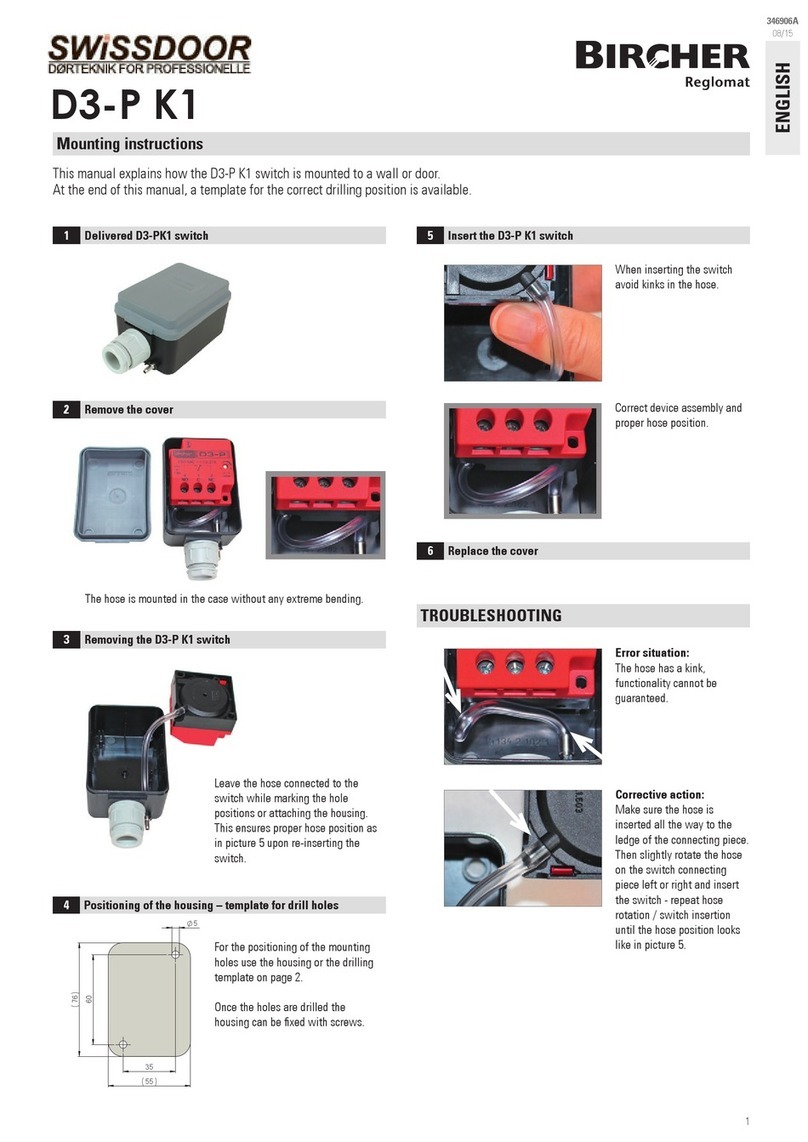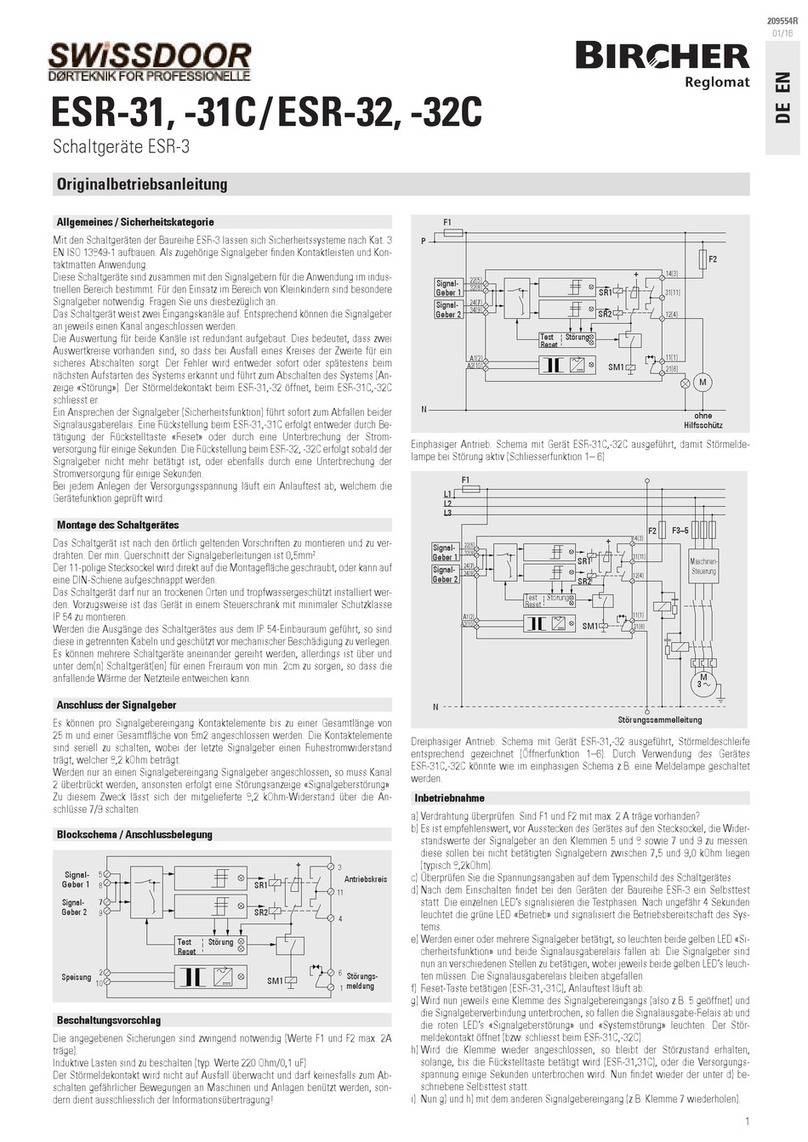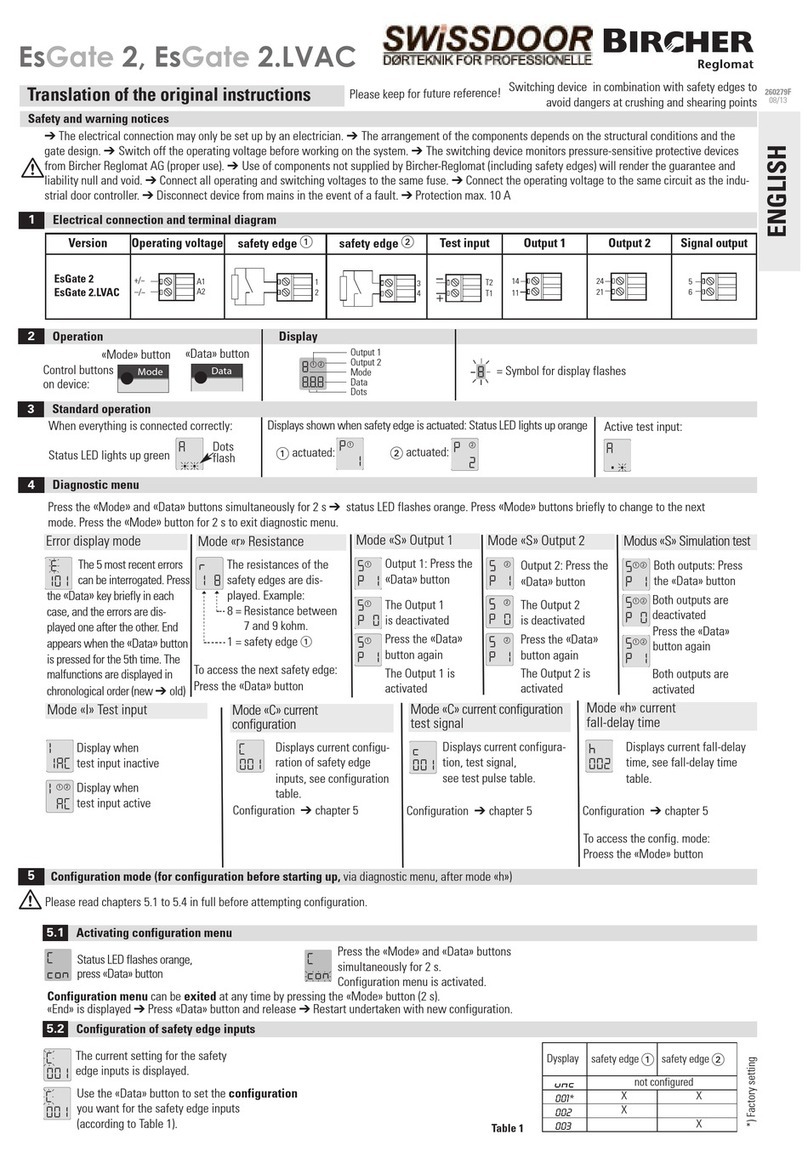1
Montage, Inbetriebnahme, Periodische Tests
1. Widerstand messen, im nicht betätigten Zustand zwischen 8,1 kOhm und
8,6 kOhm (typisch 8,2 kOhm).
2. Verdrahtung überprüfen. F1 (ESR 26: F1 und F2) mit max. 2A träge be-
stückt?
3. Einschalten des Gerätes, bei Bereitschaft leuchtet die grüne LED (beim
ESR26 beide grünen LEDs) auf.
4. Signalgeber betätigen, die entsprechende gelbe LED leuchtet auf (beim
ESR26 beide gelben LEDs), die Ausgangsrelais fallen ab.
5. Klemme eines Signalgebers ist offen, so leuchtet die rote LED (beim ESR26
beide roten LEDs), die Ausgangsrelais fallen ab.
Wichtig:
Montieren und verdrahten gemäss örtlichen Vorschriften. Minimale
Querschnitt ist 0,14 mm2. Darf nur in IP54 Gehäuse eingebaut werden.
Für periodische Tests müssen die Kontakte J1 und J4 (beim ESR26 J2 und J3)
nacheinander überbrückt werden (siehe Bestückung). Jedes mal muss ein
Stop erfolgen. Der Test «Unterbruch» wird durch Lösen des Signalgebers er-
zeugt. Stop muss erfolgen. Es wird empfohlen, die Kontrollen zu protokollie-
ren.
Die Tests sind durch geschultes Personal mit einem Werkzeug mit
isoliertem Griff vorzunehmen.
ESR25/26
Schaltgeräte
Originalbetriebsanleitung
DEUTSCH
209491S
06/16
Allgemein
Das ESR25 und das ESR26 unterscheiden sich darin, dass das ESR26 zwei
getrennte Auswertekreise hat.
Funktion
Angeschlossene Signalgeber sind mit einem Endwiderstand von 8,2 kOhm
auf Änderungen des dauernd iessenden Ruhestromes überwacht. Im Ruhe-
zustand sind beide Relais angezogen.
Bei Betätigung eines oder mehrerer Signalgeber
• sinkt der Gesamtwiderstand gegen Null Ohm
• die denierte Schaltgrenze wird unterschritten (ca. 2 kOhm)
• die Relais fallen ab
• die gelbe LED leuchtet
Bei Störung im Signalgeberkreis (Kabelbruch, Signalgeberausfall...)
• der Gesamtwiderstand steigt
• die denierte Schaltgrenze wird überschritten (ca. 9 kOhm)
• die Relais fallen ab
• die rote LED leuchtet
Status LED
Speisung Funktion grün gelb rot Ausgang
Aus offen
Ein bereit geschlossen
Ein ein Signal-Geber betätigt offen
Ein Kurzschluss oder Test offen
Ein Kabelunterbruch offen
Anschluss
• maximale Gesamtlänge des Signalgebers mit Kabel 50 m
• maximale Gesamtäche des Signalgebers 5 m2
• mehrere Signalgeber werden in Serie geschaltet
• der Gesamt-Widerstand darf 8,2 kOhm nicht übersteigen
Wichtig:
– die eingebaute Sicherung ist zwingend notwendig (dient dem
Schutz der Relaiskontakte vor «Verschweissen» bei Überlast)
– induktive Lasten sind mit einem RC-Glied zu beschalten
(220 Ohm/0,1 µF)
– periodisch sind Funktionstests durchzuführen. Es sind die dafür
vorgesehenen Prüfkontakte zu überbrücken (siehe Bestückung)
Bei Missachtung dieser Bedienungsanleitungs-Angaben wird der
Schutz des Gerätes in Frage gestellt. Der Betreiber handelt auf eige-
nes Risiko!
Blockschema
Signal-
geber 1
22(5)
32(8) R1
R3
24(7)
34(9)
A1(2)
A2(10)
Speisung
Signal-
geber 2
oder 8,2kOhm Widerstand
F1
11(1)
Antriebs-
kreis
21(6)
ESR25
• zwei parallele Signalgebereingänge
• ein Sicherheitsausgang
• Speisung 24 VACDC
• redundante Auswertung der Signalgeber
ESR26
• zwei getrennte Signalgebereingänge
• zwei getrennte Sicherheitsausgänge
• Speisung 24 VACDC
• redundante Auswertung beider Kanäle
Signal-
geber 1
22(5)
32(8)
R1
R3
R2
R4
24(7)
34(9)
A1(2)
A2(10)
Speisung
Signal-
geber 2
F1
F2
11(1)
Antriebs-
kreis 1
Antriebs-
Kreis 2
21(6)
14(3)
12(4)


























